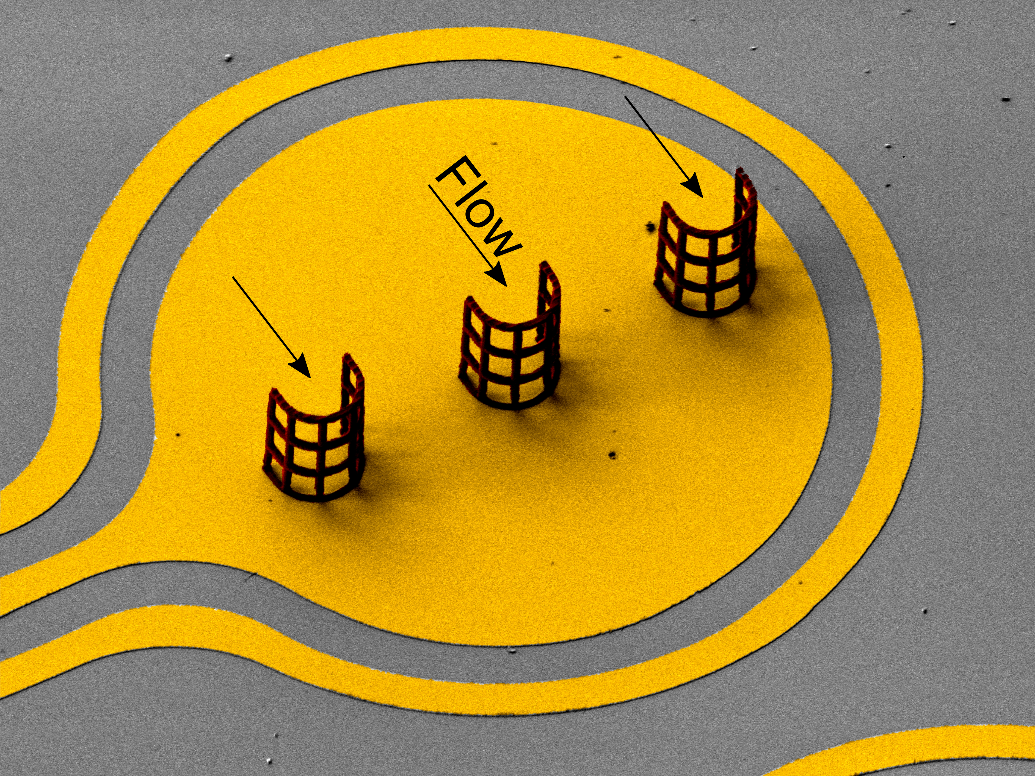CellTRAPS

ZIM project: Development of cellTRAP biochips for the analysis of binding kinetics between antibodies or antigens and cell surfaces
Abstract:
In the project cellTRAPS we develop biochips for the analysis of binding kinetics between antibodies or antigens and cell surfaces. Based on the technology of 2-photon polymerization a laser beam writes 3-dimensional trapping grids into a microfluidic channel. The cells are stopped in the flow and can be observed at a very high flow velocity.
Project description:
The ZIM project cellTRAPS is a collaboration the company Dynamic Biosensors GmbH and IMSAS. For the development of novel drugs against cancer or auto immune diseases, for instance, the binding behavior between cells and antibodies as well as the cell specificity of the antibodies are an important factor. The antibody epitope should fit very well to the surface geometry of the targeted cell. To other cells of the human body, however, the bond should be rather week in order to prevent side effects caused by the drug. To minimize costs of the development process, the immune response of the cells to the active substance should be characterized ex vivo in an early stage of the drug development.
The approach of this project is to measure the binding kinetics with immobilized cells at high flow rates in a microfluidic channel. As soon as a cell is trapped antibodies which bind more or less strong to the cell are pumped into the channel. Using fluorescent labels on the antibodies their concentration is measured. The immediate removal of unbinding antibodies from the measurement spot requires very high flow rates as well as a sufficient flow around the cell. The latter cannot be achieved with traditional 2-dimensional fabrication processes of micro technologies.
Therefore, our research focusses on printing very stable 3-dimensional cell traps with a high adhesion to the substrate which, at the same time, provide a low resistance to the flow. The trap structures are based on the hydrodynamic principle and consist of a U-shaped cylindrical grid. To fabricate grids with brace thicknesses of about 1-2 µm 2-photon polymerization is used. Here, very short laser pulses with a high intensity polymerize the resin or resist within a tiny punctual volume by the quasi simultaneous excitation with two photons („2-Photonen Polymerisation zur Erstellung fluidischer 3D-Mikrostrukturen“). In addition to the evaluation of various trap shapes and the optimization of mesh size and brace thickness also different materials (such as IP-Dip, IP-Visio and OrmoComp) are tested compared regarding their stability, print resolution, autofluorescence and cytotoxicity.
The project was funded by ZIM (Zentrales Innovationsprogramm Mittelstand https://www.zim.de/ZIM/Navigation/DE/Home/home.html ) from 01.12.2018-31.05.2021.
Publications:
S. Reede, M. J. Vellekoop, H. Müller-Landau, N. Matscheko, U. Rant, F. Lucklum. A5.3 Single Cell Immobilization at High Flow Rates Using 2PP-Traps in a Microfluidic Channel. SMSI 2020-Sensors and Instrumentation, 81-82, 2020. DOI 10.5162/SMSI2020/A5.3
Contact:
Sina Reede
IMSAS, NW1, Raum O-2150
Tel: +49 421 218 62579
E-mail: sreedeprotect me ?!imsas.uni-bremenprotect me ?!.de
Prof. Michael Vellekoop, mvellekoopprotect me ?!imsas.uni-bremenprotect me ?!.de

